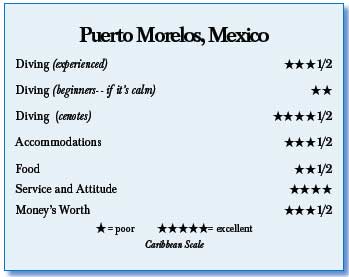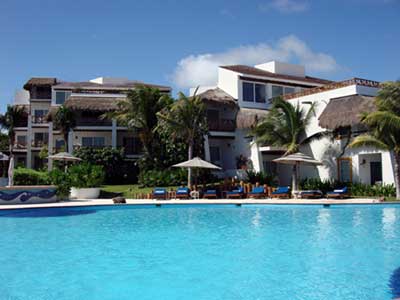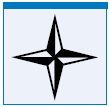Puerto Morelos, Yucatan, MexicoContents of this Issue: Dive Instructor Walks Away Free from Dead Diver Case The Mask-under-the-Chin Syndrome Puerto Morelos, Yucatan, Mexico The Only Way to Get Close to Beluga Whales: Dive Naked Amphibico Shuts Down, Deep-Sixing Buyers and Warranty Holders Litigation: The Dive Industry’s Biggest Threat? Divers Try to Speak “Dolphin-ese” Editorial Office: Ben Davison Publisher and Editor Undercurrent 3020 Bridgeway, Suite 102 Sausalito, CA 94965 decent reefs, great cenotes from the July, 2011 issue of Undercurrent
Imagine sipping mezcal on your large rooftop patio, immersed in a Jacuzzi and watching palms wave, birds dive and white foam break on the reef just offshore. It's not the Travel Channel, it's a suite at La Ceiba del Mar, just north of Puerto Morelos. It's a quiet fishing village on the hotel-and-condo-covered Rivera Maya. Or is it? According to locals, few of them fish anymore; most use their boats to take tourists fishing, snorkeling, and diving, but. It is a small town with a lot of charm, just a 20-minute cab ride from the Cancun airport. Tourism has transformed real estate values, not that there's anything wrong with that. After 25 years of diving Cozumel, staying on the mainland offered a chance to dive its very different reefs and cenotes. I chose to dive with Dive In Puerto Morelos, run by affable U.S. expat Brett Nielsen. The shop, two blocks from the town pier, is unprepossessing; small but big on service. After arriving with gear, I didn't wash or carry it until the end of the trip. Nielsen is an experienced instructor, and when I arrived, he was finishing an openwater course with a young man. While I was there in May, wind blew, waves were high, and visibility was low -- no problem for a diver with some experience, but problematic for students. The famed cenote dives are even more problematic for the novice diver because they are largely in the dark with light peeping in at the edge of caverns. The area became a national park about 10 years ago. My first dive was on a WWIIera minesweeper sold to the Mexican Navy and cleaned up to make a penetrable dive, however, some doorways were tight. Though this wreck had several names more or less agreed upon, few dive sites do. Evidently, with a few exceptions, each shop names its sites, and the marine park has given up trying to foster agreement. Like the more spectacular SS Yongala in Australia, this wreck is sunk on sand at 90 feet, with nothing else around it, and thus is a major fish attractor (or as I like to think, the only bar in a dry county). As we slipped down the mooring line, clouds of bigeye scad and anchovies appeared, with piscivores like barracuda and permits darting in and out. Two cubera snappers swam from sight, while mellower black groupers hung around, unafraid of divers. The wreck's interior was home to schools of smaller snappers, with other fishes making their way around, including a hefty lionfish (yes, they are here). In two dives on this site, I saw a large green turtle on one dive and a mating pair on the next. Patch reefs, some with small swim-throughs, predominate. Be prepared for some
impressive surge, particularly if the wind is blowing. On Puente (named for its natural
bridge), as well as its neighbors, I was astonished by the aggregations of grunts, hundreds and hundreds of French,
smallmouth, striped, blue-striped,
white, Caesars, and porkfish. Underhangs and holes in the patch reefs yielded large crabs, some spotted spiny lobsters, and eels, both spotted and green. Perhaps the most unusual fish behavior I witnessed was a school of hefty yellow jacks hunting a spotted moray at the site Parco Uno. Clearly cooperating and flashing hunting colors of reticulated yellow, the jacks chased the eel from hole to hole, striking ferociously when they could. Evidently, cooperation doesn't always work -- the eel survived -- but it was fascinating to watch. The skiff was a typical boat for the area, with a small, hard-top sunroof and benches with no padding. When the weather kicked up with rain and high seas, entering the skiff after diving was hard, even though the captain took all gear from me before I climbed the wooden ladder. My shins took a beating. Entries were backrolls, and, owing to surface currents, one submerged immediately. Both the captain and divemaster Carlos Arias, a laid-back former San Diegan, were helpful, loaded the gear and set it up the way I liked it. On one dive with low visibility, my buddy suffered a sinus squeeze,stopped descending at 25 feet, and disappeared from sight. Carlos snapped into action. He immediately went to the surface, alerted the captain, then descended and swam quickly to my buddy's entry point. Thankfully, all was well -- my buddy stayed in the same spot, the sinus cleared, and we finished the dive with some great sightings, including another large green turtle. The essentially square profiles of the area beg for enriched air, but no shop in Puerto Morelos offers it. I surfaced with at least 1,000 psi on all the dives. If I dove nitrox rather than air, the deco limits would have allowed longer dives. The local culture seems to keep intervals short, which also cuts down possible no-decompression time; though I asked and received a few more minutes on the surface, no single dive lasted more than one hour. Given the rough seas, it was fine to return to dry land, but I think most divers would prefer the option of longer dives.
However, my day of cenote diving was truly unique. All dive guides who lead cenote tours are tech divers, and Francisco, a worldly and intelligent Spaniard, was devoted to DIR diving, but not obnoxious about it. As he drove to the Chak Mool cenote, his knowledge of and enthusiasm for cenote diving shone. The entire Yucatan was originally a coral reef that arose from the seas thousands of years ago (yesterday, geologically). It is riddled with freshwater caves and caverns, flowing with crystalline rivers; cenotes nearer the shore feature haloclines of warmer seawater sitting below 30 feet. Each of the popular cenotes features guidelines through the caverns, and signs warning divers where not to go. Francisco briefed us on signals and sights, carried gear down carved rock stairs to the cenote entrance, and the first dive began. Warning: The freshwater is crystal clear but chilly, a constant 76 degrees. Bring a hooded vest, a good wetsuit and a light. But the cold water was worth the diving. The caverns were filled with stalactites (fewer stalagmites), and views through the rock windows, holes and entries featured brilliant blue and green refracted light, sometimes with trees silhouetted beyond. It was the haloclines, where fresh water meets salt water, that fascinated me most. They appeared first as lines in the water, but once immersed in their warmer salt water and adding air to compensate for its density, I was pleasingly disoriented. The best analogy I could come up with is swimming through oily quartz, as if your mask were filthy. I relaxed and followed Francisco and enjoyed the spacey sensation. Ascending into the fresh water literally clarified everything. Despite the higher cost and the colder water, I wouldn't have missed the cenote dives for anything. On the creature comfort scale, La Ceiba del Mar is good but has some problems: great beds, gorgeous pool, but electronics that often failed. Broken air conditioning and leaks in the roof meant I had to change rooms twice. There is a spa, and Joel, the therapist, is very good. The fitness center was respectably fitted out, and there was a yoga or Pilates class at 8 a.m. and 5 p.m. every day. People complain rightly about the food there -- the menu caters to western taste, and quality is not high -- but I discovered that if you ask the chef, he will make you real Mexican food, not the gussied-up bland stuff on the menu. I particularly enjoyed enchiladas with black mole and achiote-grilled shrimp. Avoid the option of all-inclusive food, because you owe it to yourself to eat in town as well as at the hotel. One civilized touch was a coffee service delivered every morning to the room at a specified time. Served with juice and baked sweet breads, it was enough for my pre-dive breakfast. Food in Puerto Morelos is quite good and cheap. Cochinita pibil, slow-roasted pig with tamarind, is available on the streets in the mornings and is delicious. Ceviche at La Playita is fresh and abundant, and the local foods at Dona Triny's are tasty and cheap (dinner for two was $18 with sodas, no beer). The walk from Puerto Morelos to the hotel is an easy 25 minutes on the beach, or five minutes and $4 by taxi. Because I am not a beach nut, the usual enticements of the Riviera Maya appeal little to me, but for a vacation with a side of diving, I would happily return. I saw a Mandarin Oriental hotel south of town, and have my eye on that for a future visit. -- A.E.L.
|

I want to get all the stories! Tell me how I can become an Undercurrent Online Member and get online access to all the articles of Undercurrent as well as thousands of first hand reports on dive operations world-wide
| Home | Online Members Area | My Account |
Login
|
Join
|
| Travel Index |
Dive Resort & Liveaboard Reviews
|
Featured Reports
|
Recent
Issues
|
Back Issues
|
|
Dive Gear
Index
|
Health/Safety Index
|
Environment & Misc.
Index
|
Seasonal Planner
|
Blogs
|
Free Articles
|
Book Picks
|
News
|
|
Special Offers
|
RSS
|
FAQ
|
About Us
|
Contact Us
|
Links
|
3020 Bridgeway, Ste 102, Sausalito, Ca 94965
All rights reserved.

 Though
different species, each featured
yellow somewhere on their bodies,
and they looked like yellow clouds
of gently milling fish with no aversion
to divers.
Though
different species, each featured
yellow somewhere on their bodies,
and they looked like yellow clouds
of gently milling fish with no aversion
to divers.
 Divers Compass: Dive In Puerto Morelos offers two-tank private dives
for $130 in the morning and $100 in the afternoon; a six-tank, threeday
ocean diving package (not private diving) is $190, and a twotank
cenote dive trip is $150, including lunch . . . All fees include
the national park wrist tag . . . La Ceiba del Mar lists rooms from
$229 to $504, though I paid $225 through
Divers Compass: Dive In Puerto Morelos offers two-tank private dives
for $130 in the morning and $100 in the afternoon; a six-tank, threeday
ocean diving package (not private diving) is $190, and a twotank
cenote dive trip is $150, including lunch . . . All fees include
the national park wrist tag . . . La Ceiba del Mar lists rooms from
$229 to $504, though I paid $225 through 